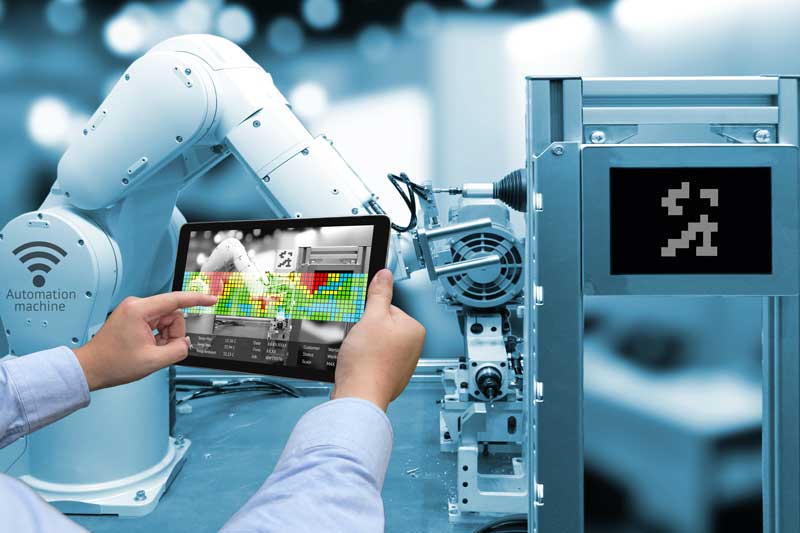U.S. manufacturers have new incentives to modernize their factories. New tax rules make it more attractive for companies to invest in equipment, allowing manufacturers to immediately deduct the full cost of equipment purchases. Previously, companies were allowed to write off only a portion of the cost in a single year.
The new rules apply for the next five years at least, creating the potential for sizable investments and modernization in U.S. factories along with opportunities to leverage the data it generates. Where might manufacturers focus their equipment investments? Here are three high-tech trends poised to change manufacturing.
Automation
Manufacturing automation has been common since the 1970s, but improvements in robotics are accelerating innovation on the factory floor. Take the apparel industry. While parts of the industry have been mechanized since the sewing machine’s debut during the Industrial Revolution, fabric is notoriously hard to work with and usually requires dexterous human hands for final assembly. In the U.S. and overseas, technology is becoming so advanced that machines now can handle pliable fabrics, stitching pockets and attaching belt loops. Atlanta-based Softwear Automation has patented “sewbots” that make clothing, home goods, and footwear on fully-automated worklines, while Adidas recently opened “Speedfactory” shoe production plants that use computerized knitting machines in the U.S. and Germany.
In addition to “sewbots,” technological improvements have brought us “cobots”: robots that work alongside and in collaboration with humans. These robots often are mobile, agile, and equipped with sensors. They can handle multiple tasks such as “pick and place” operations, making factory work less repetitive and physically taxing for humans. Amazon is on the forefront of automation. In late 2017, it estimated it had already put more than 100,000 robots to work, including roving shelves and mechanical arms that help humans improve the company’s warehouse efficiencies.
Virtual reality
Virtual or augmented reality (VR/AR) is another futuristic-sounding technology that’s actually in place today. More than one in three U.S. manufacturers already use or plan to adopt VR/AR technologies by 2018, according to a PwC survey. Ford was an early adopter. The automaker uses virtual reality throughout its design, engineering, and manufacturing processes. In manufacturing, for example, Ford employs immersive VR and full-body motion sensors to capture how workers move, facilitating the design of production lines that are efficient and ergonomically safe.
Many other companies use virtual overlays to aid training, assembly, and repairs. VR/AR can speed on-boarding of new employees by giving them more thorough and immersive training. Complex assembly is easier for workers when step-by-step instructions and illustrations are “glanceable” in their field of vision. Employees can keep their hands on their task rather than walking away to find an instruction manual. Similarly, VR/AR can expedite a variety of maintenance work. For example, the company that runs Boston’s commuter trains gives AR smart glasses to field mechanics, allowing them to share information and collaborate with expert technicians in the central maintenance facility.
Additive manufacturing
Additive manufacturing—the industrial version of 3D printing—can help companies make prototypes, parts, and repairs quickly and less expensively. The technology’s adoption is widespread, from the smallest companies to some of the biggest. GE, Ford, and the U.S. Navy all rely on additive manufacturing to make parts to precise specifications. Ford recently told The Wall Street Journal that it has used 3-D printing to make more than 700,000 parts in the past five years, resulting in an estimated $200 million in savings!
Generating and leveraging more data
By effectively cutting the cost of equipment, new tax rules invite U.S. manufacturers to replace aging machinery and speed up their modernization. This sets the stage for growing investments in automation, VR/AR, additive manufacturing, and other technologies, each of which requires a digital platform and puts IT to use throughout the production process. Manufacturers who modernize create opportunities to collect and leverage data throughout the production cycle. Analyzing that data can give them greater insights into improving quality, efficiency, and throughput, maximize production speed and reduce operational costs. These high-tech trends are no longer just hype. More and more they are becoming realities—innovations that might just get an extra nudge forward by the new tax rules.
Sources
- “The Robots Are Coming for Garment Workers,” by Jon Emont, The Wall Street Journal, February 16, 2018.
- “Tax Incentives Put More Robots on Factory Floors,” by Andrew Tangel and Patrick McGroaty, The Wall Street Journal, January 26, 2018.
- “What Can Augmented Reality Do for Manufacturing,” by Ian Wright, engineering.com, May 2017.
- Survey Says: Healthcare CIOs Don’t Fully Trust Their Data - November 8, 2018
- Microhospitals: How a New Healthcare Model Leverages Business Intelligence - September 25, 2018
- How New Database Technology Fuels Oil Company’s Analytics - September 20, 2018



